IBS803 Report: The Warehouse Group's India Market Entry Strategy
VerifiedAdded on 2022/12/20
|22
|5371
|26
Report
AI Summary
This report examines The Warehouse Group (TWG), a New Zealand-based retail company, and its potential entry into the rapidly growing Indian retail market. The report begins with an overview of the Indian retail landscape, highlighting its competitiveness and profitability, and analyzes various entry modes including exporting, licensing and franchising, and strategic alliances. The core of the report focuses on strategic alliances as the most suitable entry mode for TWG, considering the existing market dynamics and the presence of established players. It also discusses the organizational structure that would support this strategy, value creation, and profit generation. The report concludes with recommendations for TWG's management, emphasizing the importance of in-depth market analysis, an innovative product line, and the potential future shift towards opening a wholly owned subsidiary. The assignment uses the Avon case study to provide context for the analysis.
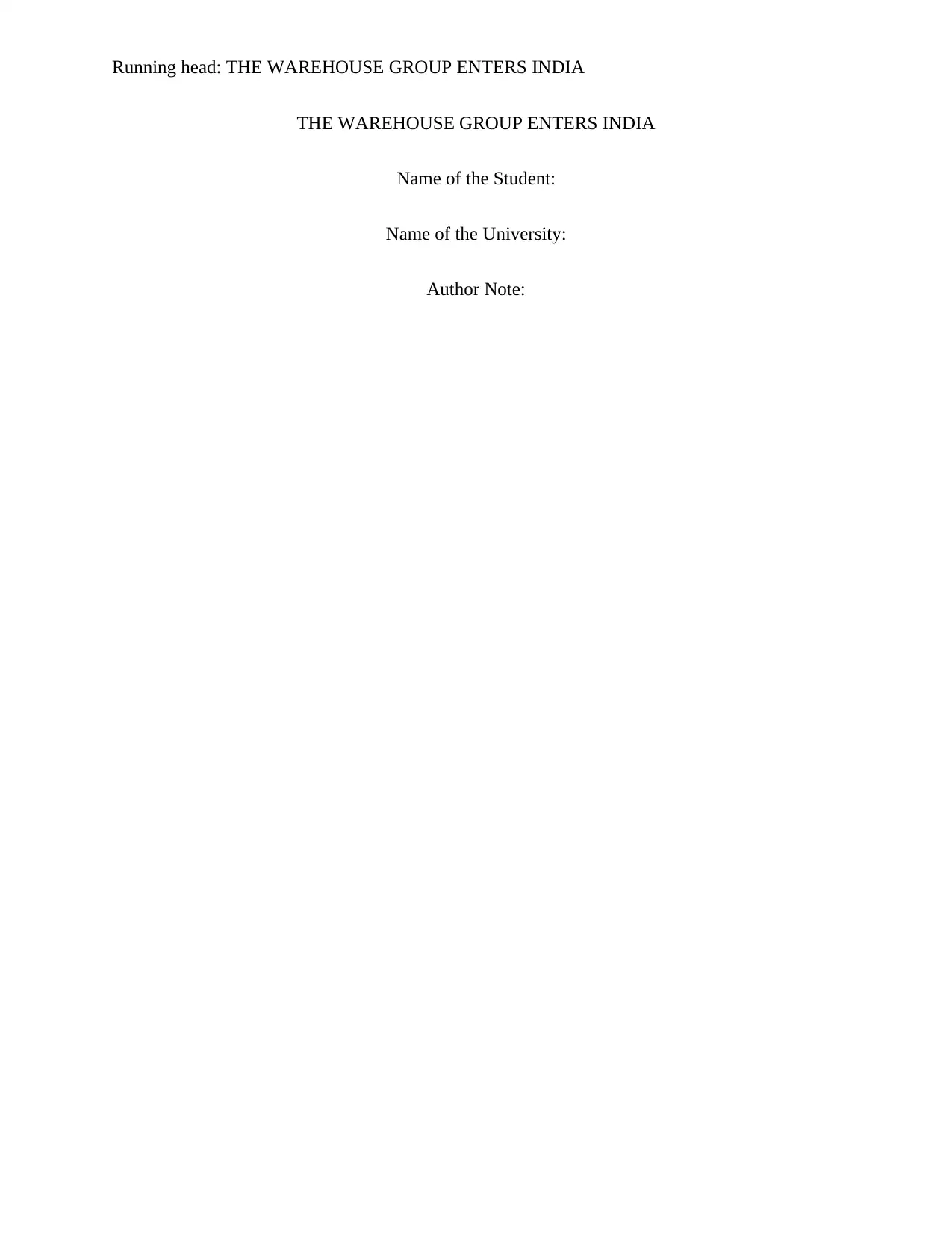
Running head: THE WAREHOUSE GROUP ENTERS INDIA
THE WAREHOUSE GROUP ENTERS INDIA
Name of the Student:
Name of the University:
Author Note:
THE WAREHOUSE GROUP ENTERS INDIA
Name of the Student:
Name of the University:
Author Note:
Paraphrase This Document
Need a fresh take? Get an instant paraphrase of this document with our AI Paraphraser
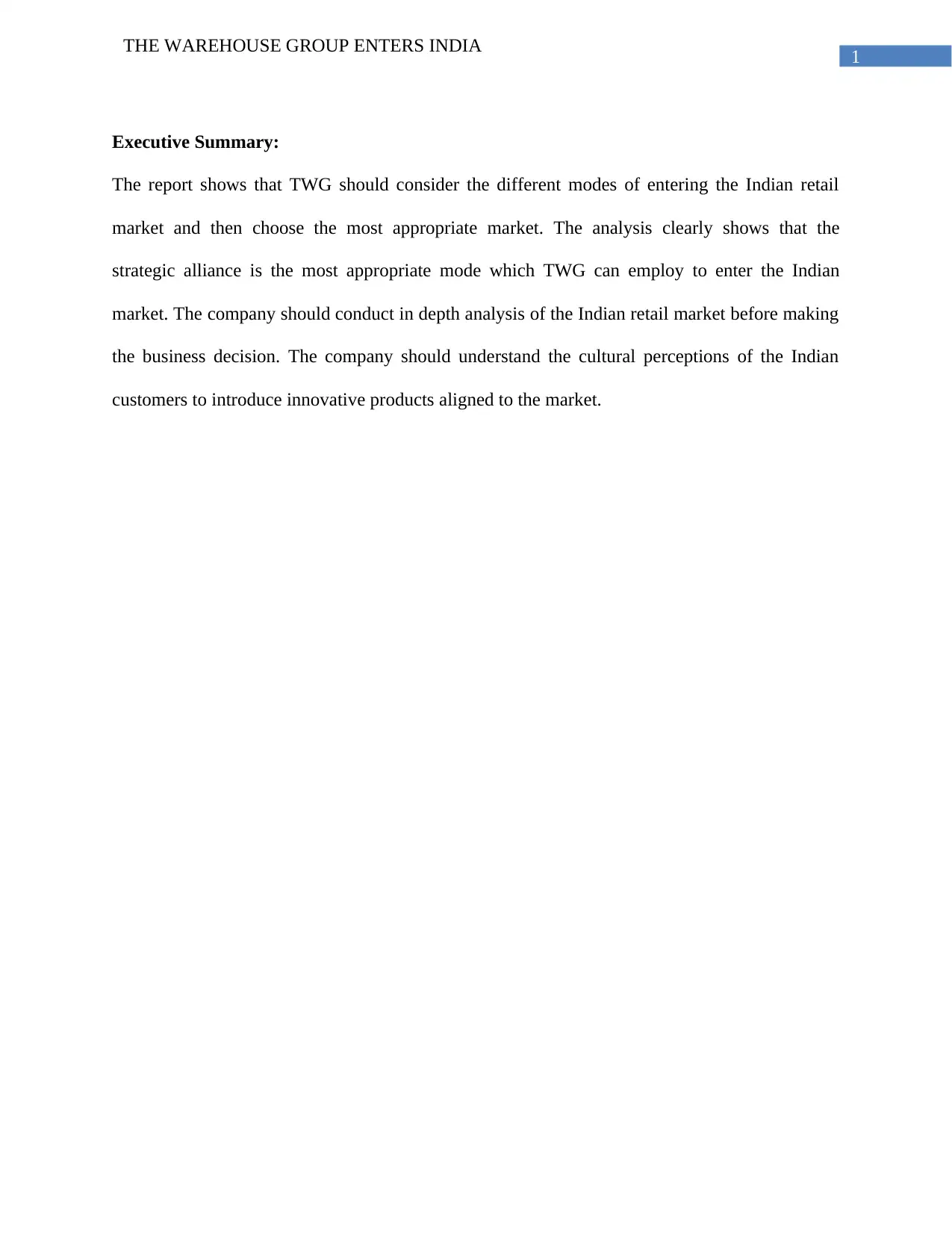
1
THE WAREHOUSE GROUP ENTERS INDIA
Executive Summary:
The report shows that TWG should consider the different modes of entering the Indian retail
market and then choose the most appropriate market. The analysis clearly shows that the
strategic alliance is the most appropriate mode which TWG can employ to enter the Indian
market. The company should conduct in depth analysis of the Indian retail market before making
the business decision. The company should understand the cultural perceptions of the Indian
customers to introduce innovative products aligned to the market.
THE WAREHOUSE GROUP ENTERS INDIA
Executive Summary:
The report shows that TWG should consider the different modes of entering the Indian retail
market and then choose the most appropriate market. The analysis clearly shows that the
strategic alliance is the most appropriate mode which TWG can employ to enter the Indian
market. The company should conduct in depth analysis of the Indian retail market before making
the business decision. The company should understand the cultural perceptions of the Indian
customers to introduce innovative products aligned to the market.
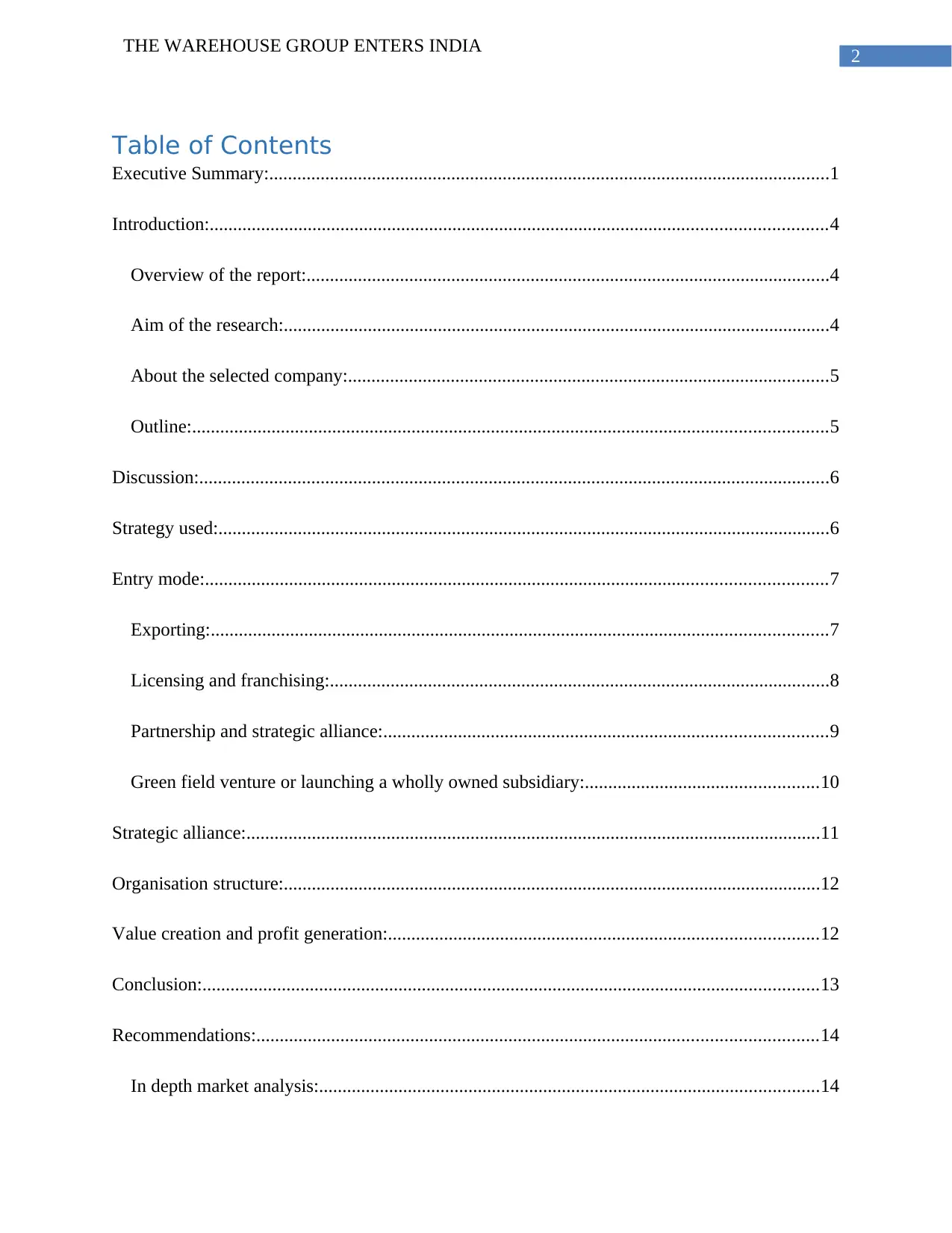
2
THE WAREHOUSE GROUP ENTERS INDIA
Table of Contents
Executive Summary:........................................................................................................................1
Introduction:....................................................................................................................................4
Overview of the report:................................................................................................................4
Aim of the research:.....................................................................................................................4
About the selected company:.......................................................................................................5
Outline:........................................................................................................................................5
Discussion:.......................................................................................................................................6
Strategy used:...................................................................................................................................6
Entry mode:.....................................................................................................................................7
Exporting:....................................................................................................................................7
Licensing and franchising:...........................................................................................................8
Partnership and strategic alliance:...............................................................................................9
Green field venture or launching a wholly owned subsidiary:..................................................10
Strategic alliance:...........................................................................................................................11
Organisation structure:...................................................................................................................12
Value creation and profit generation:............................................................................................12
Conclusion:....................................................................................................................................13
Recommendations:........................................................................................................................14
In depth market analysis:...........................................................................................................14
THE WAREHOUSE GROUP ENTERS INDIA
Table of Contents
Executive Summary:........................................................................................................................1
Introduction:....................................................................................................................................4
Overview of the report:................................................................................................................4
Aim of the research:.....................................................................................................................4
About the selected company:.......................................................................................................5
Outline:........................................................................................................................................5
Discussion:.......................................................................................................................................6
Strategy used:...................................................................................................................................6
Entry mode:.....................................................................................................................................7
Exporting:....................................................................................................................................7
Licensing and franchising:...........................................................................................................8
Partnership and strategic alliance:...............................................................................................9
Green field venture or launching a wholly owned subsidiary:..................................................10
Strategic alliance:...........................................................................................................................11
Organisation structure:...................................................................................................................12
Value creation and profit generation:............................................................................................12
Conclusion:....................................................................................................................................13
Recommendations:........................................................................................................................14
In depth market analysis:...........................................................................................................14
⊘ This is a preview!⊘
Do you want full access?
Subscribe today to unlock all pages.

Trusted by 1+ million students worldwide
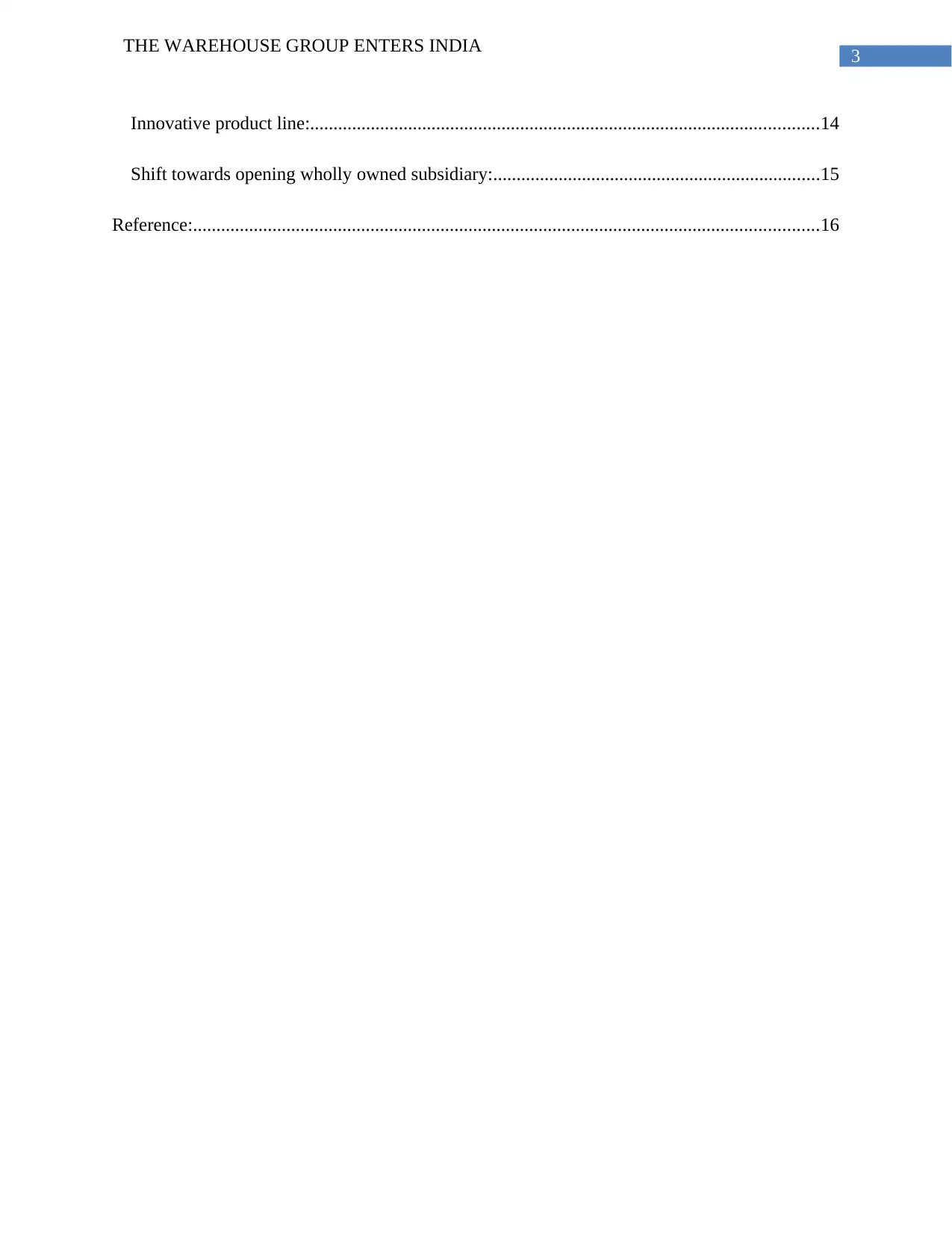
3
THE WAREHOUSE GROUP ENTERS INDIA
Innovative product line:.............................................................................................................14
Shift towards opening wholly owned subsidiary:......................................................................15
Reference:......................................................................................................................................16
THE WAREHOUSE GROUP ENTERS INDIA
Innovative product line:.............................................................................................................14
Shift towards opening wholly owned subsidiary:......................................................................15
Reference:......................................................................................................................................16
Paraphrase This Document
Need a fresh take? Get an instant paraphrase of this document with our AI Paraphraser
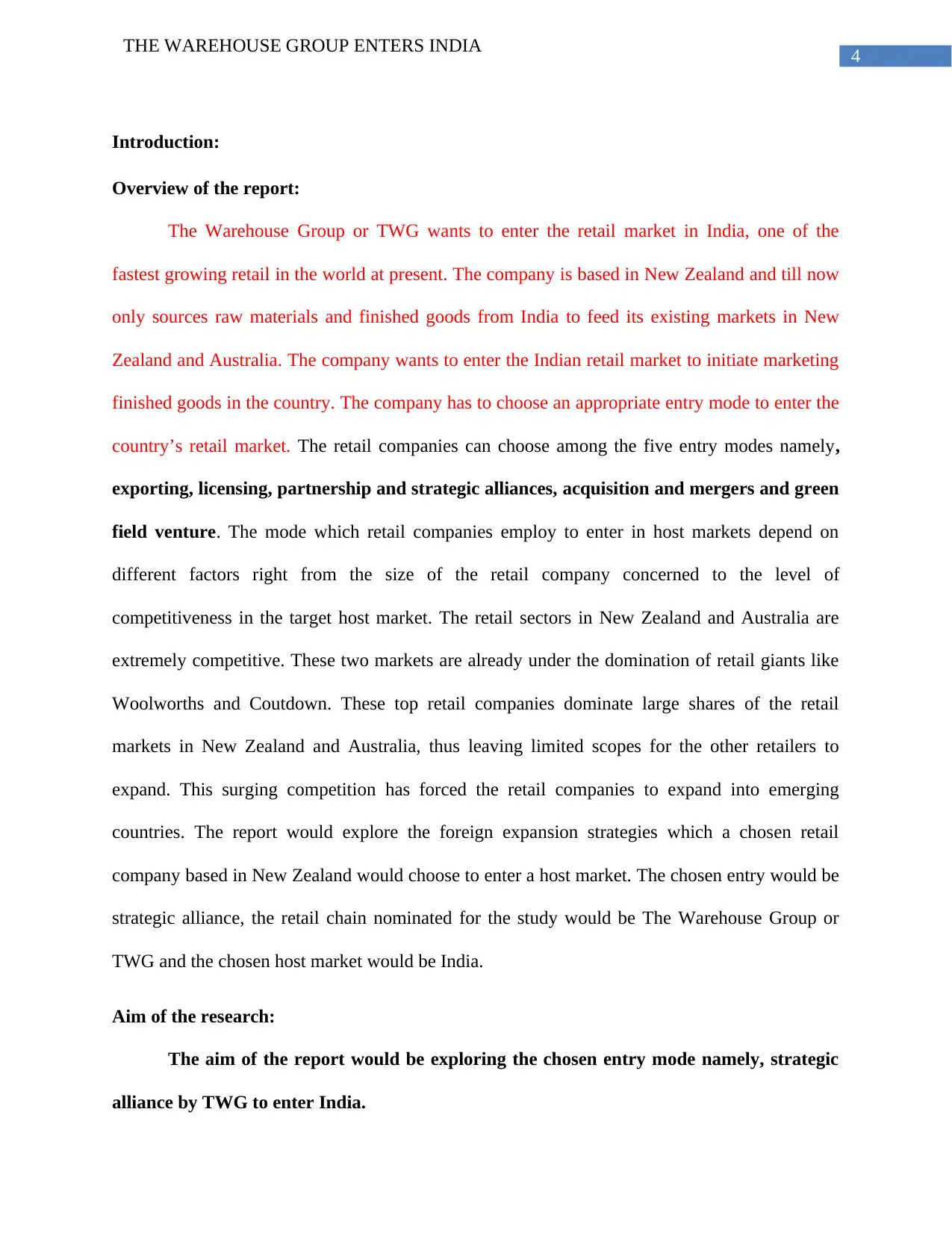
4
THE WAREHOUSE GROUP ENTERS INDIA
Introduction:
Overview of the report:
The Warehouse Group or TWG wants to enter the retail market in India, one of the
fastest growing retail in the world at present. The company is based in New Zealand and till now
only sources raw materials and finished goods from India to feed its existing markets in New
Zealand and Australia. The company wants to enter the Indian retail market to initiate marketing
finished goods in the country. The company has to choose an appropriate entry mode to enter the
country’s retail market. The retail companies can choose among the five entry modes namely,
exporting, licensing, partnership and strategic alliances, acquisition and mergers and green
field venture. The mode which retail companies employ to enter in host markets depend on
different factors right from the size of the retail company concerned to the level of
competitiveness in the target host market. The retail sectors in New Zealand and Australia are
extremely competitive. These two markets are already under the domination of retail giants like
Woolworths and Coutdown. These top retail companies dominate large shares of the retail
markets in New Zealand and Australia, thus leaving limited scopes for the other retailers to
expand. This surging competition has forced the retail companies to expand into emerging
countries. The report would explore the foreign expansion strategies which a chosen retail
company based in New Zealand would choose to enter a host market. The chosen entry would be
strategic alliance, the retail chain nominated for the study would be The Warehouse Group or
TWG and the chosen host market would be India.
Aim of the research:
The aim of the report would be exploring the chosen entry mode namely, strategic
alliance by TWG to enter India.
THE WAREHOUSE GROUP ENTERS INDIA
Introduction:
Overview of the report:
The Warehouse Group or TWG wants to enter the retail market in India, one of the
fastest growing retail in the world at present. The company is based in New Zealand and till now
only sources raw materials and finished goods from India to feed its existing markets in New
Zealand and Australia. The company wants to enter the Indian retail market to initiate marketing
finished goods in the country. The company has to choose an appropriate entry mode to enter the
country’s retail market. The retail companies can choose among the five entry modes namely,
exporting, licensing, partnership and strategic alliances, acquisition and mergers and green
field venture. The mode which retail companies employ to enter in host markets depend on
different factors right from the size of the retail company concerned to the level of
competitiveness in the target host market. The retail sectors in New Zealand and Australia are
extremely competitive. These two markets are already under the domination of retail giants like
Woolworths and Coutdown. These top retail companies dominate large shares of the retail
markets in New Zealand and Australia, thus leaving limited scopes for the other retailers to
expand. This surging competition has forced the retail companies to expand into emerging
countries. The report would explore the foreign expansion strategies which a chosen retail
company based in New Zealand would choose to enter a host market. The chosen entry would be
strategic alliance, the retail chain nominated for the study would be The Warehouse Group or
TWG and the chosen host market would be India.
Aim of the research:
The aim of the report would be exploring the chosen entry mode namely, strategic
alliance by TWG to enter India.
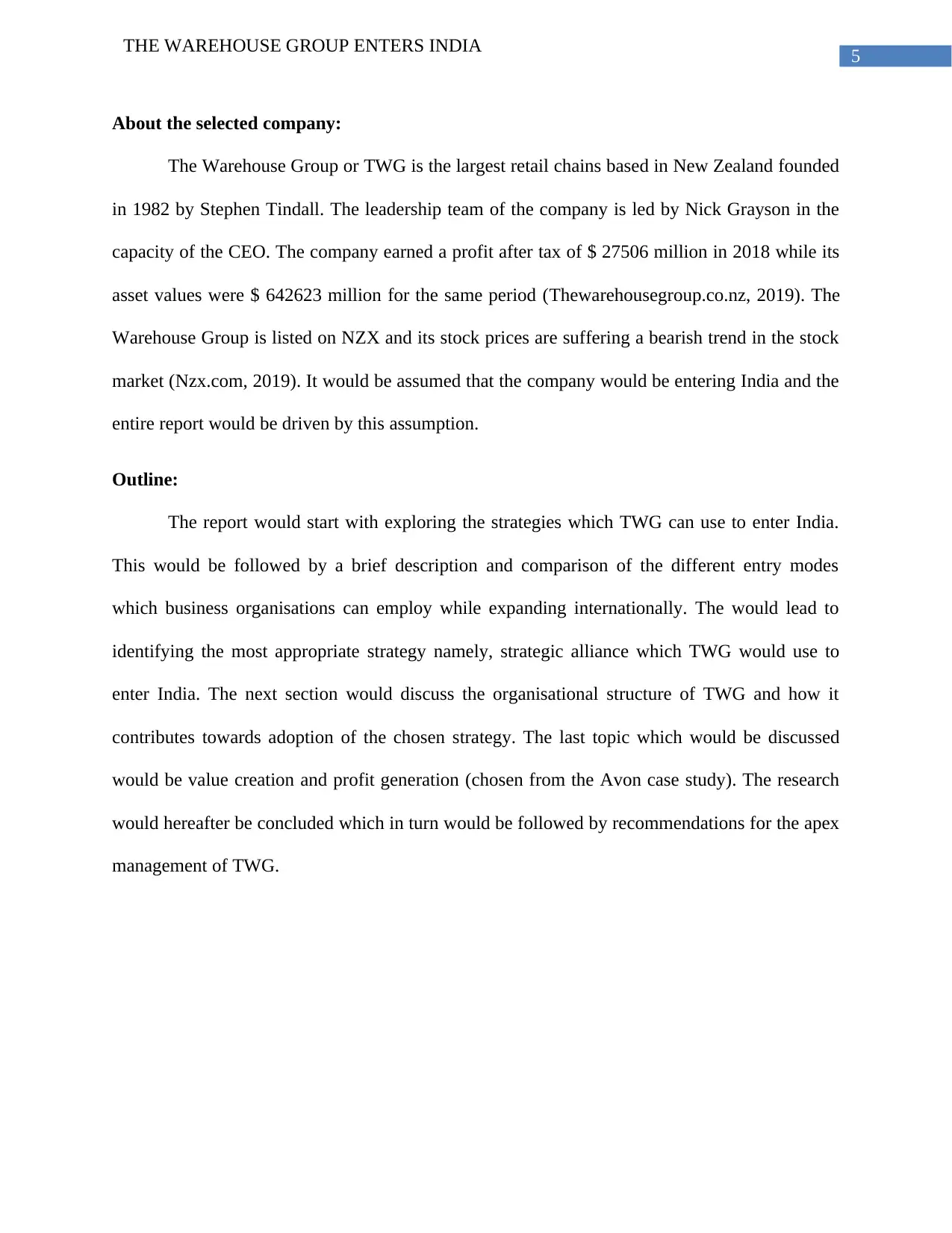
5
THE WAREHOUSE GROUP ENTERS INDIA
About the selected company:
The Warehouse Group or TWG is the largest retail chains based in New Zealand founded
in 1982 by Stephen Tindall. The leadership team of the company is led by Nick Grayson in the
capacity of the CEO. The company earned a profit after tax of $ 27506 million in 2018 while its
asset values were $ 642623 million for the same period (Thewarehousegroup.co.nz, 2019). The
Warehouse Group is listed on NZX and its stock prices are suffering a bearish trend in the stock
market (Nzx.com, 2019). It would be assumed that the company would be entering India and the
entire report would be driven by this assumption.
Outline:
The report would start with exploring the strategies which TWG can use to enter India.
This would be followed by a brief description and comparison of the different entry modes
which business organisations can employ while expanding internationally. The would lead to
identifying the most appropriate strategy namely, strategic alliance which TWG would use to
enter India. The next section would discuss the organisational structure of TWG and how it
contributes towards adoption of the chosen strategy. The last topic which would be discussed
would be value creation and profit generation (chosen from the Avon case study). The research
would hereafter be concluded which in turn would be followed by recommendations for the apex
management of TWG.
THE WAREHOUSE GROUP ENTERS INDIA
About the selected company:
The Warehouse Group or TWG is the largest retail chains based in New Zealand founded
in 1982 by Stephen Tindall. The leadership team of the company is led by Nick Grayson in the
capacity of the CEO. The company earned a profit after tax of $ 27506 million in 2018 while its
asset values were $ 642623 million for the same period (Thewarehousegroup.co.nz, 2019). The
Warehouse Group is listed on NZX and its stock prices are suffering a bearish trend in the stock
market (Nzx.com, 2019). It would be assumed that the company would be entering India and the
entire report would be driven by this assumption.
Outline:
The report would start with exploring the strategies which TWG can use to enter India.
This would be followed by a brief description and comparison of the different entry modes
which business organisations can employ while expanding internationally. The would lead to
identifying the most appropriate strategy namely, strategic alliance which TWG would use to
enter India. The next section would discuss the organisational structure of TWG and how it
contributes towards adoption of the chosen strategy. The last topic which would be discussed
would be value creation and profit generation (chosen from the Avon case study). The research
would hereafter be concluded which in turn would be followed by recommendations for the apex
management of TWG.
⊘ This is a preview!⊘
Do you want full access?
Subscribe today to unlock all pages.

Trusted by 1+ million students worldwide
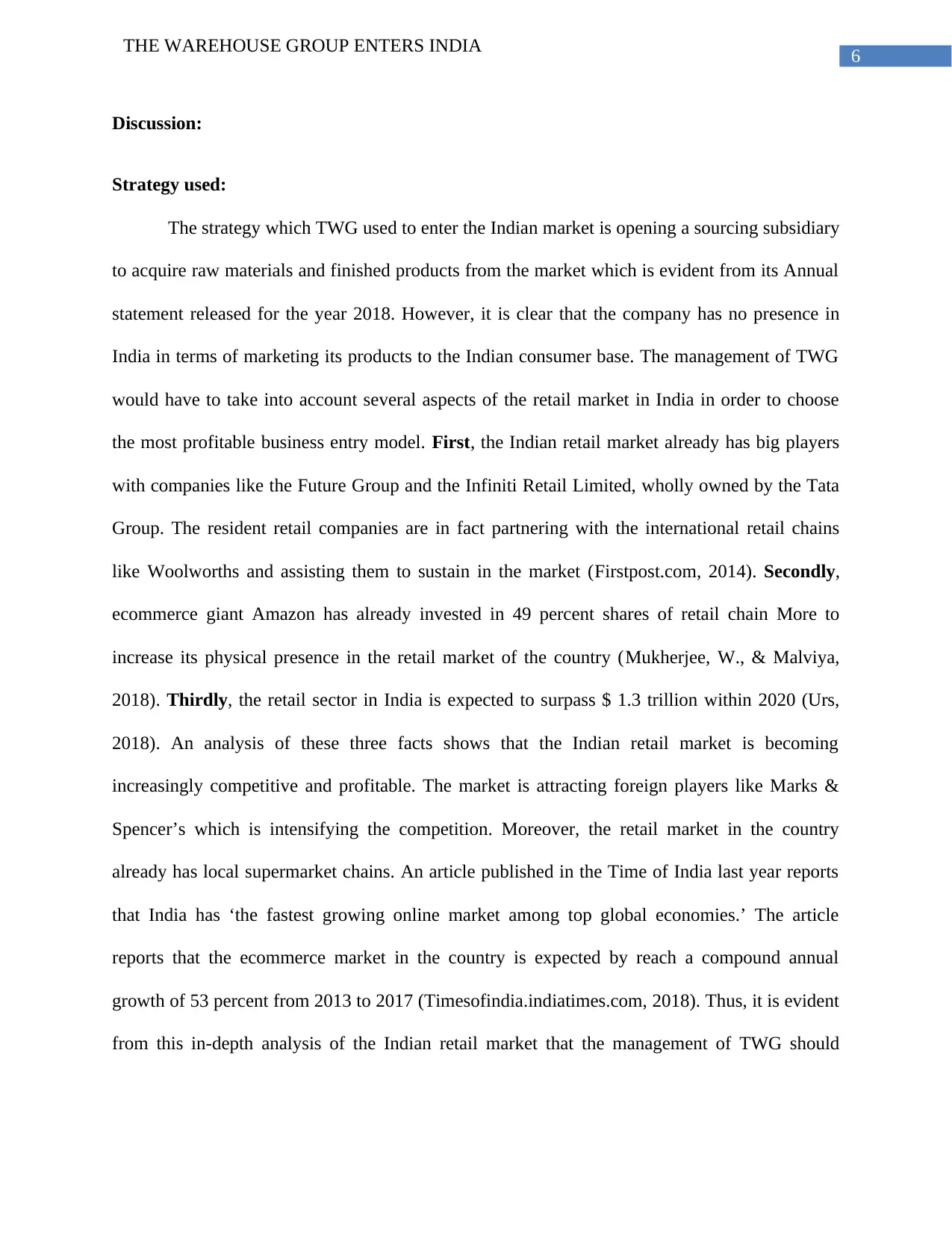
6
THE WAREHOUSE GROUP ENTERS INDIA
Discussion:
Strategy used:
The strategy which TWG used to enter the Indian market is opening a sourcing subsidiary
to acquire raw materials and finished products from the market which is evident from its Annual
statement released for the year 2018. However, it is clear that the company has no presence in
India in terms of marketing its products to the Indian consumer base. The management of TWG
would have to take into account several aspects of the retail market in India in order to choose
the most profitable business entry model. First, the Indian retail market already has big players
with companies like the Future Group and the Infiniti Retail Limited, wholly owned by the Tata
Group. The resident retail companies are in fact partnering with the international retail chains
like Woolworths and assisting them to sustain in the market (Firstpost.com, 2014). Secondly,
ecommerce giant Amazon has already invested in 49 percent shares of retail chain More to
increase its physical presence in the retail market of the country (Mukherjee, W., & Malviya,
2018). Thirdly, the retail sector in India is expected to surpass $ 1.3 trillion within 2020 (Urs,
2018). An analysis of these three facts shows that the Indian retail market is becoming
increasingly competitive and profitable. The market is attracting foreign players like Marks &
Spencer’s which is intensifying the competition. Moreover, the retail market in the country
already has local supermarket chains. An article published in the Time of India last year reports
that India has ‘the fastest growing online market among top global economies.’ The article
reports that the ecommerce market in the country is expected by reach a compound annual
growth of 53 percent from 2013 to 2017 (Timesofindia.indiatimes.com, 2018). Thus, it is evident
from this in-depth analysis of the Indian retail market that the management of TWG should
THE WAREHOUSE GROUP ENTERS INDIA
Discussion:
Strategy used:
The strategy which TWG used to enter the Indian market is opening a sourcing subsidiary
to acquire raw materials and finished products from the market which is evident from its Annual
statement released for the year 2018. However, it is clear that the company has no presence in
India in terms of marketing its products to the Indian consumer base. The management of TWG
would have to take into account several aspects of the retail market in India in order to choose
the most profitable business entry model. First, the Indian retail market already has big players
with companies like the Future Group and the Infiniti Retail Limited, wholly owned by the Tata
Group. The resident retail companies are in fact partnering with the international retail chains
like Woolworths and assisting them to sustain in the market (Firstpost.com, 2014). Secondly,
ecommerce giant Amazon has already invested in 49 percent shares of retail chain More to
increase its physical presence in the retail market of the country (Mukherjee, W., & Malviya,
2018). Thirdly, the retail sector in India is expected to surpass $ 1.3 trillion within 2020 (Urs,
2018). An analysis of these three facts shows that the Indian retail market is becoming
increasingly competitive and profitable. The market is attracting foreign players like Marks &
Spencer’s which is intensifying the competition. Moreover, the retail market in the country
already has local supermarket chains. An article published in the Time of India last year reports
that India has ‘the fastest growing online market among top global economies.’ The article
reports that the ecommerce market in the country is expected by reach a compound annual
growth of 53 percent from 2013 to 2017 (Timesofindia.indiatimes.com, 2018). Thus, it is evident
from this in-depth analysis of the Indian retail market that the management of TWG should
Paraphrase This Document
Need a fresh take? Get an instant paraphrase of this document with our AI Paraphraser
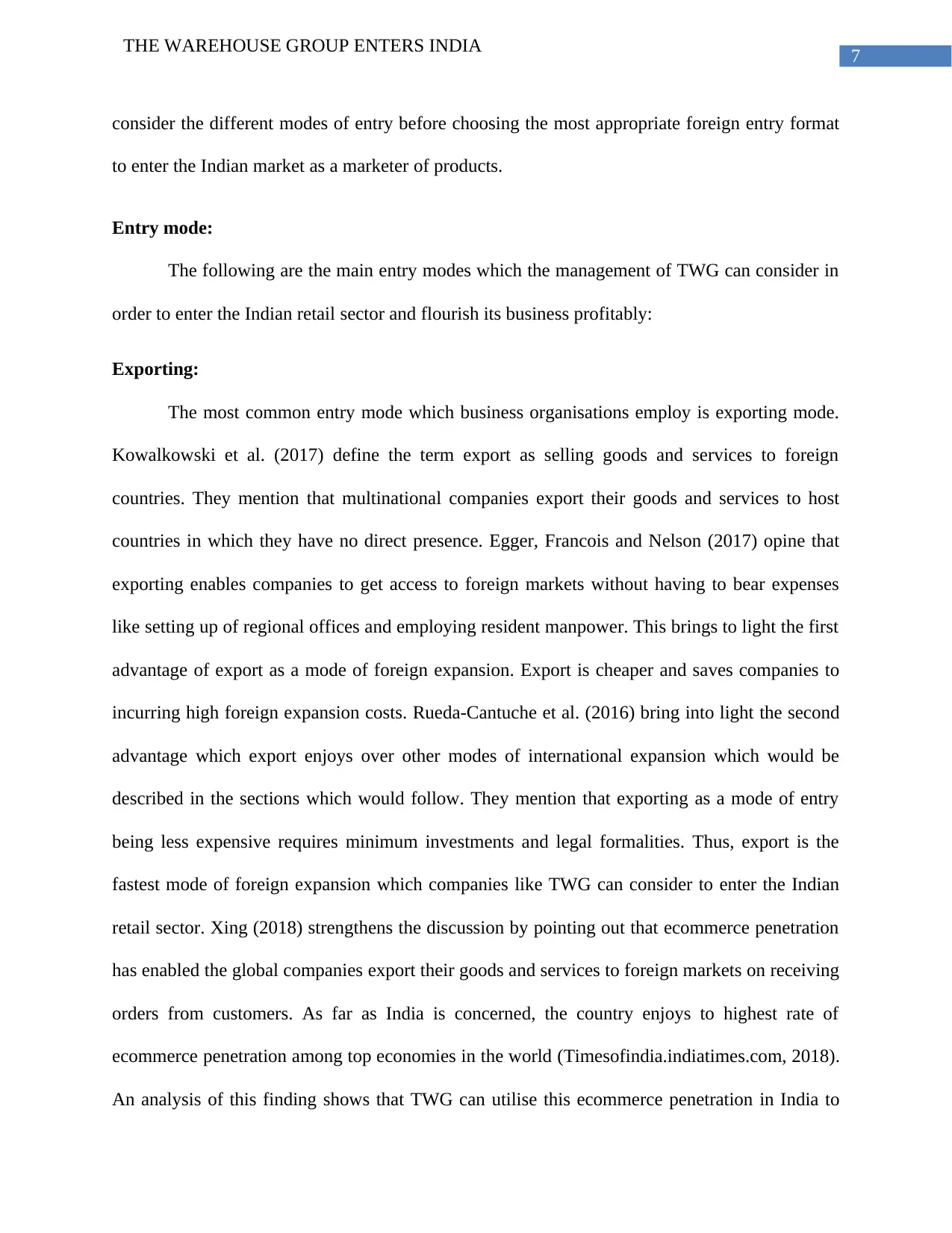
7
THE WAREHOUSE GROUP ENTERS INDIA
consider the different modes of entry before choosing the most appropriate foreign entry format
to enter the Indian market as a marketer of products.
Entry mode:
The following are the main entry modes which the management of TWG can consider in
order to enter the Indian retail sector and flourish its business profitably:
Exporting:
The most common entry mode which business organisations employ is exporting mode.
Kowalkowski et al. (2017) define the term export as selling goods and services to foreign
countries. They mention that multinational companies export their goods and services to host
countries in which they have no direct presence. Egger, Francois and Nelson (2017) opine that
exporting enables companies to get access to foreign markets without having to bear expenses
like setting up of regional offices and employing resident manpower. This brings to light the first
advantage of export as a mode of foreign expansion. Export is cheaper and saves companies to
incurring high foreign expansion costs. Rueda-Cantuche et al. (2016) bring into light the second
advantage which export enjoys over other modes of international expansion which would be
described in the sections which would follow. They mention that exporting as a mode of entry
being less expensive requires minimum investments and legal formalities. Thus, export is the
fastest mode of foreign expansion which companies like TWG can consider to enter the Indian
retail sector. Xing (2018) strengthens the discussion by pointing out that ecommerce penetration
has enabled the global companies export their goods and services to foreign markets on receiving
orders from customers. As far as India is concerned, the country enjoys to highest rate of
ecommerce penetration among top economies in the world (Timesofindia.indiatimes.com, 2018).
An analysis of this finding shows that TWG can utilise this ecommerce penetration in India to
THE WAREHOUSE GROUP ENTERS INDIA
consider the different modes of entry before choosing the most appropriate foreign entry format
to enter the Indian market as a marketer of products.
Entry mode:
The following are the main entry modes which the management of TWG can consider in
order to enter the Indian retail sector and flourish its business profitably:
Exporting:
The most common entry mode which business organisations employ is exporting mode.
Kowalkowski et al. (2017) define the term export as selling goods and services to foreign
countries. They mention that multinational companies export their goods and services to host
countries in which they have no direct presence. Egger, Francois and Nelson (2017) opine that
exporting enables companies to get access to foreign markets without having to bear expenses
like setting up of regional offices and employing resident manpower. This brings to light the first
advantage of export as a mode of foreign expansion. Export is cheaper and saves companies to
incurring high foreign expansion costs. Rueda-Cantuche et al. (2016) bring into light the second
advantage which export enjoys over other modes of international expansion which would be
described in the sections which would follow. They mention that exporting as a mode of entry
being less expensive requires minimum investments and legal formalities. Thus, export is the
fastest mode of foreign expansion which companies like TWG can consider to enter the Indian
retail sector. Xing (2018) strengthens the discussion by pointing out that ecommerce penetration
has enabled the global companies export their goods and services to foreign markets on receiving
orders from customers. As far as India is concerned, the country enjoys to highest rate of
ecommerce penetration among top economies in the world (Timesofindia.indiatimes.com, 2018).
An analysis of this finding shows that TWG can utilise this ecommerce penetration in India to
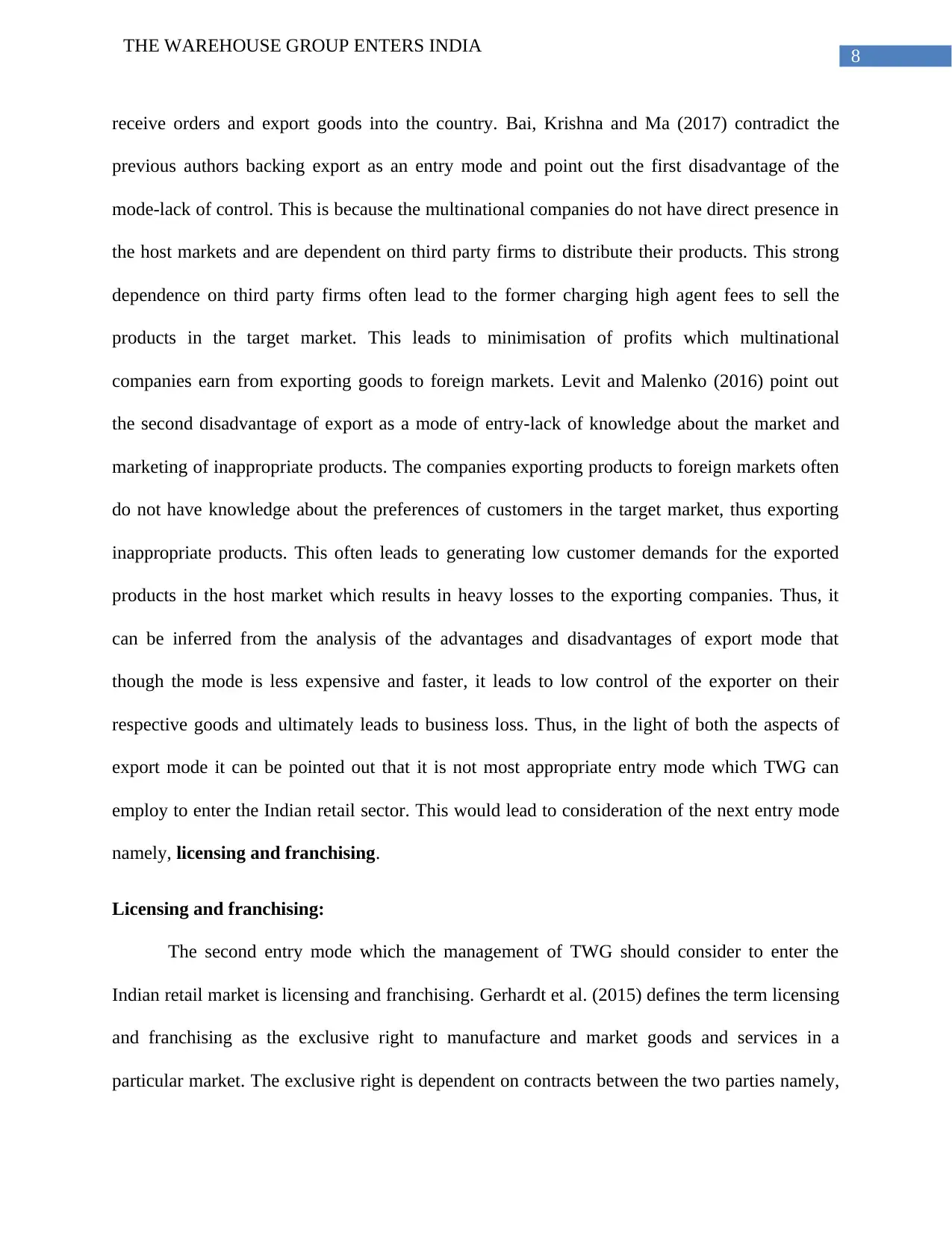
8
THE WAREHOUSE GROUP ENTERS INDIA
receive orders and export goods into the country. Bai, Krishna and Ma (2017) contradict the
previous authors backing export as an entry mode and point out the first disadvantage of the
mode-lack of control. This is because the multinational companies do not have direct presence in
the host markets and are dependent on third party firms to distribute their products. This strong
dependence on third party firms often lead to the former charging high agent fees to sell the
products in the target market. This leads to minimisation of profits which multinational
companies earn from exporting goods to foreign markets. Levit and Malenko (2016) point out
the second disadvantage of export as a mode of entry-lack of knowledge about the market and
marketing of inappropriate products. The companies exporting products to foreign markets often
do not have knowledge about the preferences of customers in the target market, thus exporting
inappropriate products. This often leads to generating low customer demands for the exported
products in the host market which results in heavy losses to the exporting companies. Thus, it
can be inferred from the analysis of the advantages and disadvantages of export mode that
though the mode is less expensive and faster, it leads to low control of the exporter on their
respective goods and ultimately leads to business loss. Thus, in the light of both the aspects of
export mode it can be pointed out that it is not most appropriate entry mode which TWG can
employ to enter the Indian retail sector. This would lead to consideration of the next entry mode
namely, licensing and franchising.
Licensing and franchising:
The second entry mode which the management of TWG should consider to enter the
Indian retail market is licensing and franchising. Gerhardt et al. (2015) defines the term licensing
and franchising as the exclusive right to manufacture and market goods and services in a
particular market. The exclusive right is dependent on contracts between the two parties namely,
THE WAREHOUSE GROUP ENTERS INDIA
receive orders and export goods into the country. Bai, Krishna and Ma (2017) contradict the
previous authors backing export as an entry mode and point out the first disadvantage of the
mode-lack of control. This is because the multinational companies do not have direct presence in
the host markets and are dependent on third party firms to distribute their products. This strong
dependence on third party firms often lead to the former charging high agent fees to sell the
products in the target market. This leads to minimisation of profits which multinational
companies earn from exporting goods to foreign markets. Levit and Malenko (2016) point out
the second disadvantage of export as a mode of entry-lack of knowledge about the market and
marketing of inappropriate products. The companies exporting products to foreign markets often
do not have knowledge about the preferences of customers in the target market, thus exporting
inappropriate products. This often leads to generating low customer demands for the exported
products in the host market which results in heavy losses to the exporting companies. Thus, it
can be inferred from the analysis of the advantages and disadvantages of export mode that
though the mode is less expensive and faster, it leads to low control of the exporter on their
respective goods and ultimately leads to business loss. Thus, in the light of both the aspects of
export mode it can be pointed out that it is not most appropriate entry mode which TWG can
employ to enter the Indian retail sector. This would lead to consideration of the next entry mode
namely, licensing and franchising.
Licensing and franchising:
The second entry mode which the management of TWG should consider to enter the
Indian retail market is licensing and franchising. Gerhardt et al. (2015) defines the term licensing
and franchising as the exclusive right to manufacture and market goods and services in a
particular market. The exclusive right is dependent on contracts between the two parties namely,
⊘ This is a preview!⊘
Do you want full access?
Subscribe today to unlock all pages.

Trusted by 1+ million students worldwide
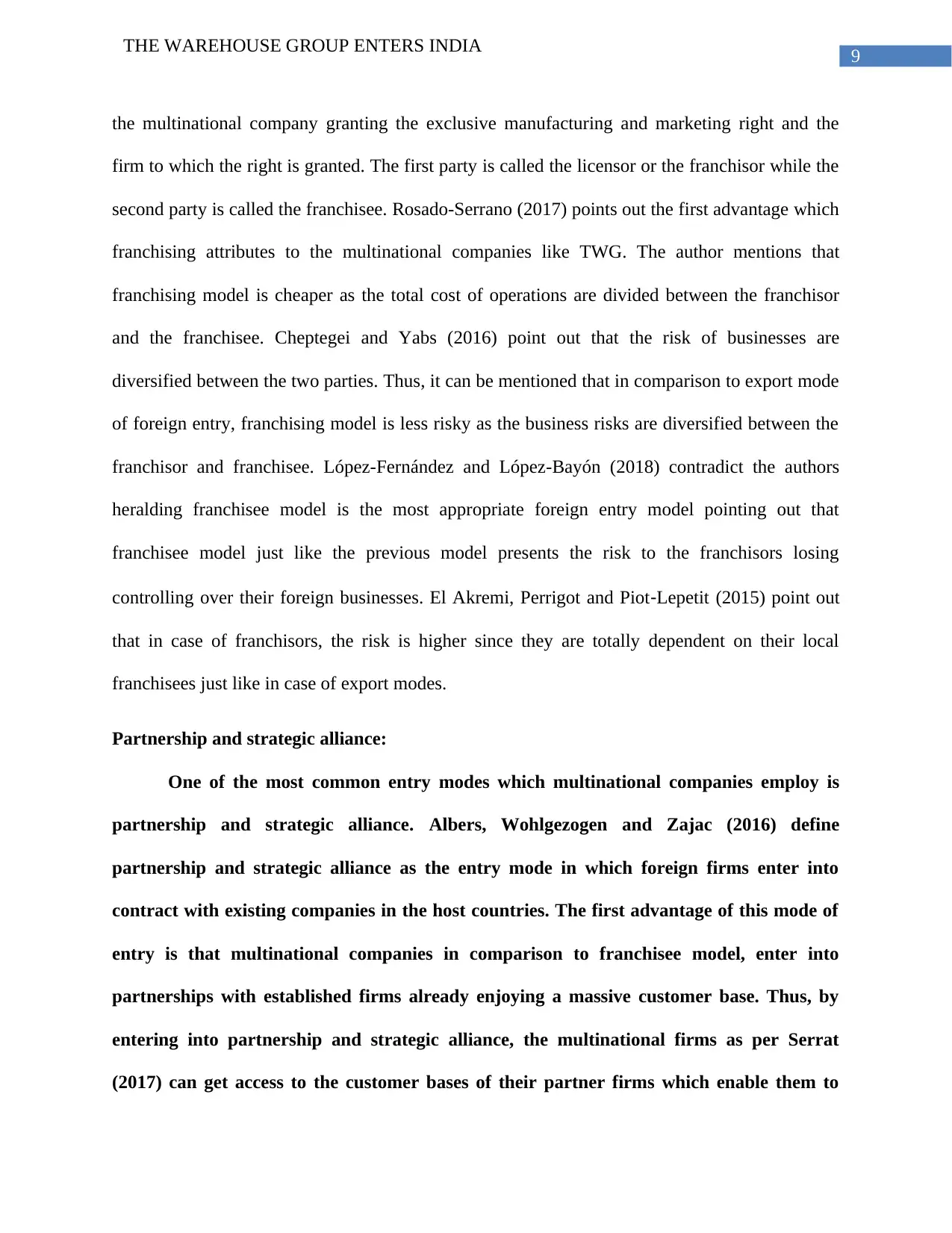
9
THE WAREHOUSE GROUP ENTERS INDIA
the multinational company granting the exclusive manufacturing and marketing right and the
firm to which the right is granted. The first party is called the licensor or the franchisor while the
second party is called the franchisee. Rosado-Serrano (2017) points out the first advantage which
franchising attributes to the multinational companies like TWG. The author mentions that
franchising model is cheaper as the total cost of operations are divided between the franchisor
and the franchisee. Cheptegei and Yabs (2016) point out that the risk of businesses are
diversified between the two parties. Thus, it can be mentioned that in comparison to export mode
of foreign entry, franchising model is less risky as the business risks are diversified between the
franchisor and franchisee. López-Fernández and López-Bayón (2018) contradict the authors
heralding franchisee model is the most appropriate foreign entry model pointing out that
franchisee model just like the previous model presents the risk to the franchisors losing
controlling over their foreign businesses. El Akremi, Perrigot and Piot‐Lepetit (2015) point out
that in case of franchisors, the risk is higher since they are totally dependent on their local
franchisees just like in case of export modes.
Partnership and strategic alliance:
One of the most common entry modes which multinational companies employ is
partnership and strategic alliance. Albers, Wohlgezogen and Zajac (2016) define
partnership and strategic alliance as the entry mode in which foreign firms enter into
contract with existing companies in the host countries. The first advantage of this mode of
entry is that multinational companies in comparison to franchisee model, enter into
partnerships with established firms already enjoying a massive customer base. Thus, by
entering into partnership and strategic alliance, the multinational firms as per Serrat
(2017) can get access to the customer bases of their partner firms which enable them to
THE WAREHOUSE GROUP ENTERS INDIA
the multinational company granting the exclusive manufacturing and marketing right and the
firm to which the right is granted. The first party is called the licensor or the franchisor while the
second party is called the franchisee. Rosado-Serrano (2017) points out the first advantage which
franchising attributes to the multinational companies like TWG. The author mentions that
franchising model is cheaper as the total cost of operations are divided between the franchisor
and the franchisee. Cheptegei and Yabs (2016) point out that the risk of businesses are
diversified between the two parties. Thus, it can be mentioned that in comparison to export mode
of foreign entry, franchising model is less risky as the business risks are diversified between the
franchisor and franchisee. López-Fernández and López-Bayón (2018) contradict the authors
heralding franchisee model is the most appropriate foreign entry model pointing out that
franchisee model just like the previous model presents the risk to the franchisors losing
controlling over their foreign businesses. El Akremi, Perrigot and Piot‐Lepetit (2015) point out
that in case of franchisors, the risk is higher since they are totally dependent on their local
franchisees just like in case of export modes.
Partnership and strategic alliance:
One of the most common entry modes which multinational companies employ is
partnership and strategic alliance. Albers, Wohlgezogen and Zajac (2016) define
partnership and strategic alliance as the entry mode in which foreign firms enter into
contract with existing companies in the host countries. The first advantage of this mode of
entry is that multinational companies in comparison to franchisee model, enter into
partnerships with established firms already enjoying a massive customer base. Thus, by
entering into partnership and strategic alliance, the multinational firms as per Serrat
(2017) can get access to the customer bases of their partner firms which enable them to
Paraphrase This Document
Need a fresh take? Get an instant paraphrase of this document with our AI Paraphraser
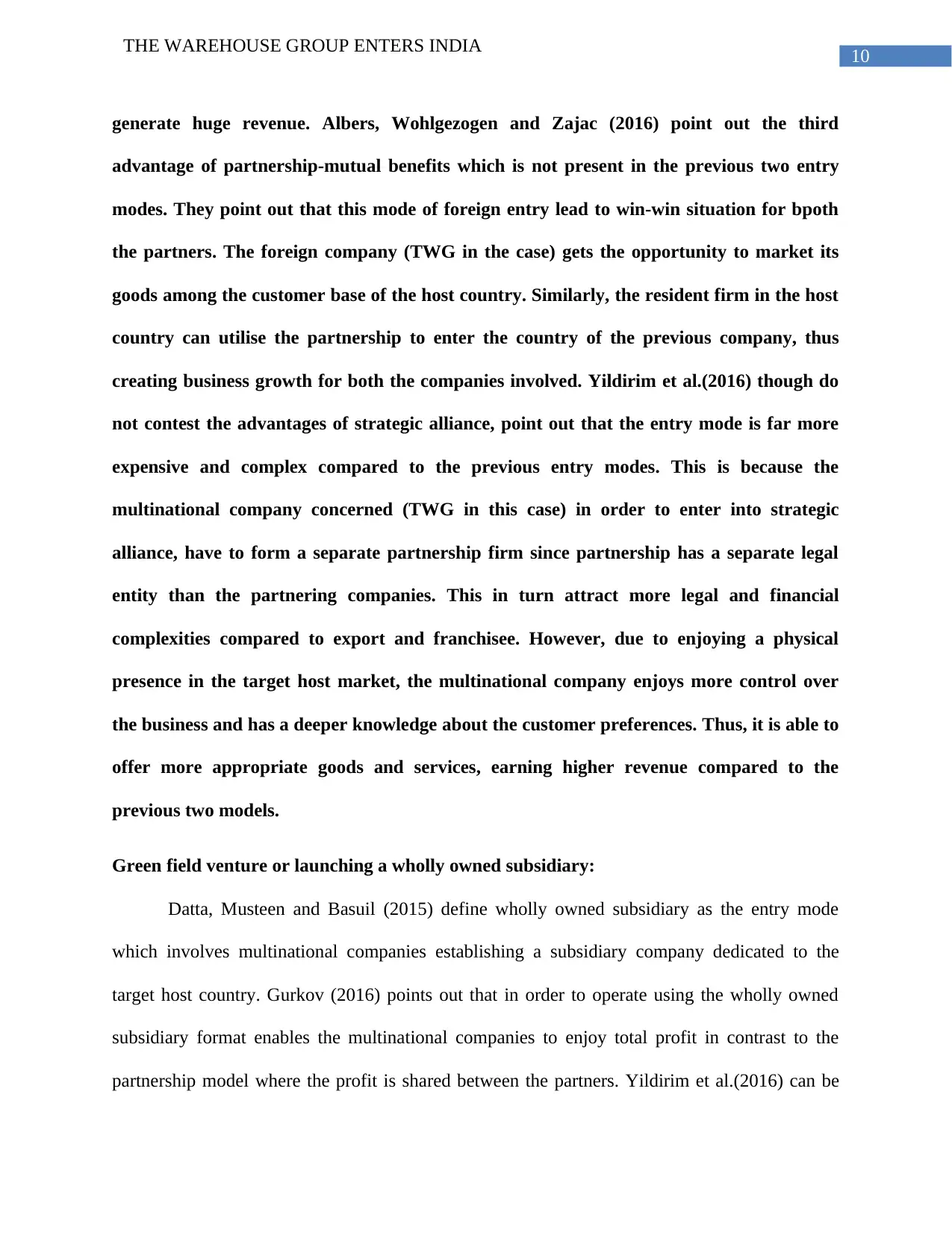
10
THE WAREHOUSE GROUP ENTERS INDIA
generate huge revenue. Albers, Wohlgezogen and Zajac (2016) point out the third
advantage of partnership-mutual benefits which is not present in the previous two entry
modes. They point out that this mode of foreign entry lead to win-win situation for bpoth
the partners. The foreign company (TWG in the case) gets the opportunity to market its
goods among the customer base of the host country. Similarly, the resident firm in the host
country can utilise the partnership to enter the country of the previous company, thus
creating business growth for both the companies involved. Yildirim et al.(2016) though do
not contest the advantages of strategic alliance, point out that the entry mode is far more
expensive and complex compared to the previous entry modes. This is because the
multinational company concerned (TWG in this case) in order to enter into strategic
alliance, have to form a separate partnership firm since partnership has a separate legal
entity than the partnering companies. This in turn attract more legal and financial
complexities compared to export and franchisee. However, due to enjoying a physical
presence in the target host market, the multinational company enjoys more control over
the business and has a deeper knowledge about the customer preferences. Thus, it is able to
offer more appropriate goods and services, earning higher revenue compared to the
previous two models.
Green field venture or launching a wholly owned subsidiary:
Datta, Musteen and Basuil (2015) define wholly owned subsidiary as the entry mode
which involves multinational companies establishing a subsidiary company dedicated to the
target host country. Gurkov (2016) points out that in order to operate using the wholly owned
subsidiary format enables the multinational companies to enjoy total profit in contrast to the
partnership model where the profit is shared between the partners. Yildirim et al.(2016) can be
THE WAREHOUSE GROUP ENTERS INDIA
generate huge revenue. Albers, Wohlgezogen and Zajac (2016) point out the third
advantage of partnership-mutual benefits which is not present in the previous two entry
modes. They point out that this mode of foreign entry lead to win-win situation for bpoth
the partners. The foreign company (TWG in the case) gets the opportunity to market its
goods among the customer base of the host country. Similarly, the resident firm in the host
country can utilise the partnership to enter the country of the previous company, thus
creating business growth for both the companies involved. Yildirim et al.(2016) though do
not contest the advantages of strategic alliance, point out that the entry mode is far more
expensive and complex compared to the previous entry modes. This is because the
multinational company concerned (TWG in this case) in order to enter into strategic
alliance, have to form a separate partnership firm since partnership has a separate legal
entity than the partnering companies. This in turn attract more legal and financial
complexities compared to export and franchisee. However, due to enjoying a physical
presence in the target host market, the multinational company enjoys more control over
the business and has a deeper knowledge about the customer preferences. Thus, it is able to
offer more appropriate goods and services, earning higher revenue compared to the
previous two models.
Green field venture or launching a wholly owned subsidiary:
Datta, Musteen and Basuil (2015) define wholly owned subsidiary as the entry mode
which involves multinational companies establishing a subsidiary company dedicated to the
target host country. Gurkov (2016) points out that in order to operate using the wholly owned
subsidiary format enables the multinational companies to enjoy total profit in contrast to the
partnership model where the profit is shared between the partners. Yildirim et al.(2016) can be
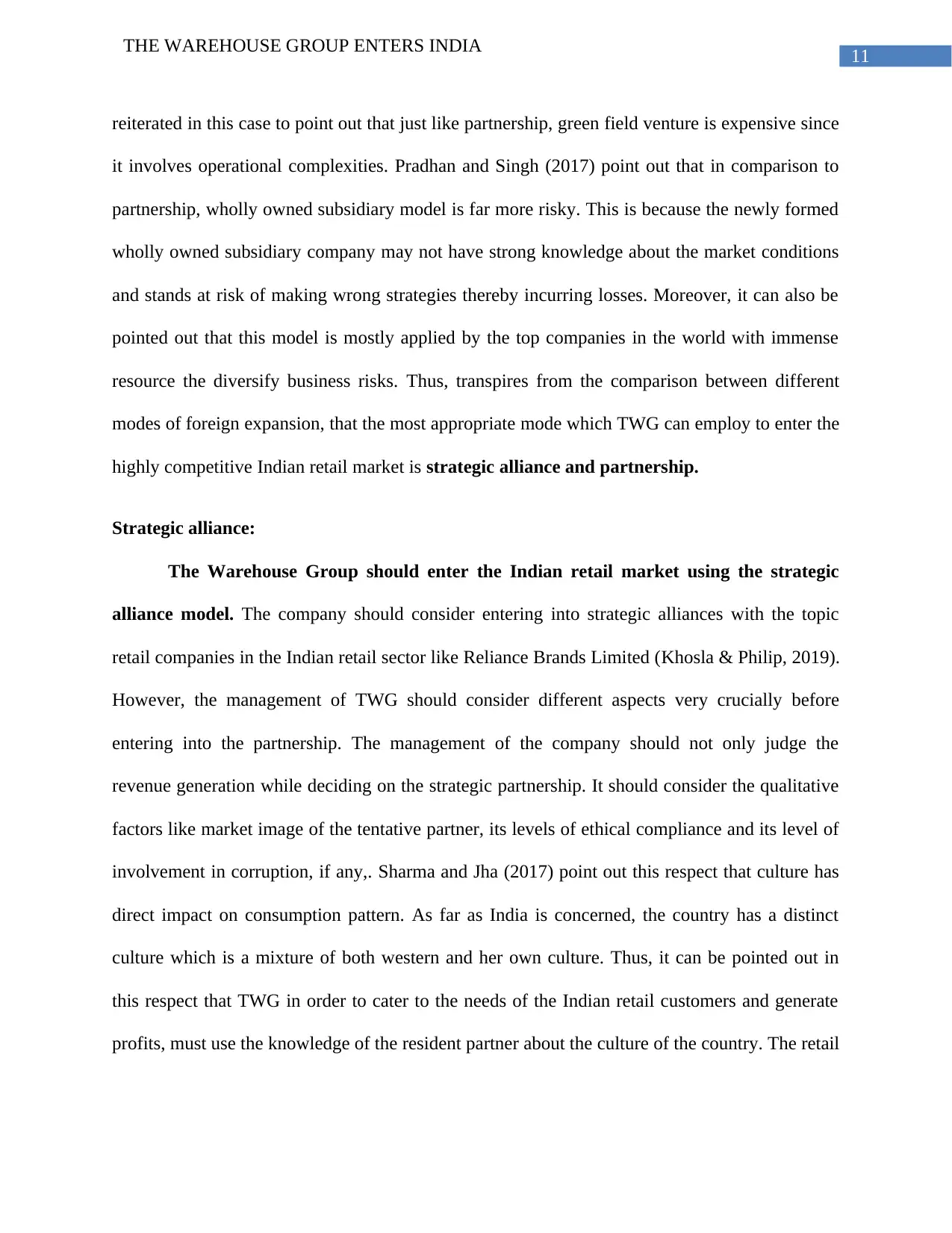
11
THE WAREHOUSE GROUP ENTERS INDIA
reiterated in this case to point out that just like partnership, green field venture is expensive since
it involves operational complexities. Pradhan and Singh (2017) point out that in comparison to
partnership, wholly owned subsidiary model is far more risky. This is because the newly formed
wholly owned subsidiary company may not have strong knowledge about the market conditions
and stands at risk of making wrong strategies thereby incurring losses. Moreover, it can also be
pointed out that this model is mostly applied by the top companies in the world with immense
resource the diversify business risks. Thus, transpires from the comparison between different
modes of foreign expansion, that the most appropriate mode which TWG can employ to enter the
highly competitive Indian retail market is strategic alliance and partnership.
Strategic alliance:
The Warehouse Group should enter the Indian retail market using the strategic
alliance model. The company should consider entering into strategic alliances with the topic
retail companies in the Indian retail sector like Reliance Brands Limited (Khosla & Philip, 2019).
However, the management of TWG should consider different aspects very crucially before
entering into the partnership. The management of the company should not only judge the
revenue generation while deciding on the strategic partnership. It should consider the qualitative
factors like market image of the tentative partner, its levels of ethical compliance and its level of
involvement in corruption, if any,. Sharma and Jha (2017) point out this respect that culture has
direct impact on consumption pattern. As far as India is concerned, the country has a distinct
culture which is a mixture of both western and her own culture. Thus, it can be pointed out in
this respect that TWG in order to cater to the needs of the Indian retail customers and generate
profits, must use the knowledge of the resident partner about the culture of the country. The retail
THE WAREHOUSE GROUP ENTERS INDIA
reiterated in this case to point out that just like partnership, green field venture is expensive since
it involves operational complexities. Pradhan and Singh (2017) point out that in comparison to
partnership, wholly owned subsidiary model is far more risky. This is because the newly formed
wholly owned subsidiary company may not have strong knowledge about the market conditions
and stands at risk of making wrong strategies thereby incurring losses. Moreover, it can also be
pointed out that this model is mostly applied by the top companies in the world with immense
resource the diversify business risks. Thus, transpires from the comparison between different
modes of foreign expansion, that the most appropriate mode which TWG can employ to enter the
highly competitive Indian retail market is strategic alliance and partnership.
Strategic alliance:
The Warehouse Group should enter the Indian retail market using the strategic
alliance model. The company should consider entering into strategic alliances with the topic
retail companies in the Indian retail sector like Reliance Brands Limited (Khosla & Philip, 2019).
However, the management of TWG should consider different aspects very crucially before
entering into the partnership. The management of the company should not only judge the
revenue generation while deciding on the strategic partnership. It should consider the qualitative
factors like market image of the tentative partner, its levels of ethical compliance and its level of
involvement in corruption, if any,. Sharma and Jha (2017) point out this respect that culture has
direct impact on consumption pattern. As far as India is concerned, the country has a distinct
culture which is a mixture of both western and her own culture. Thus, it can be pointed out in
this respect that TWG in order to cater to the needs of the Indian retail customers and generate
profits, must use the knowledge of the resident partner about the culture of the country. The retail
⊘ This is a preview!⊘
Do you want full access?
Subscribe today to unlock all pages.

Trusted by 1+ million students worldwide
1 out of 22
Related Documents
Your All-in-One AI-Powered Toolkit for Academic Success.
+13062052269
info@desklib.com
Available 24*7 on WhatsApp / Email
![[object Object]](/_next/static/media/star-bottom.7253800d.svg)
Unlock your academic potential
Copyright © 2020–2025 A2Z Services. All Rights Reserved. Developed and managed by ZUCOL.




